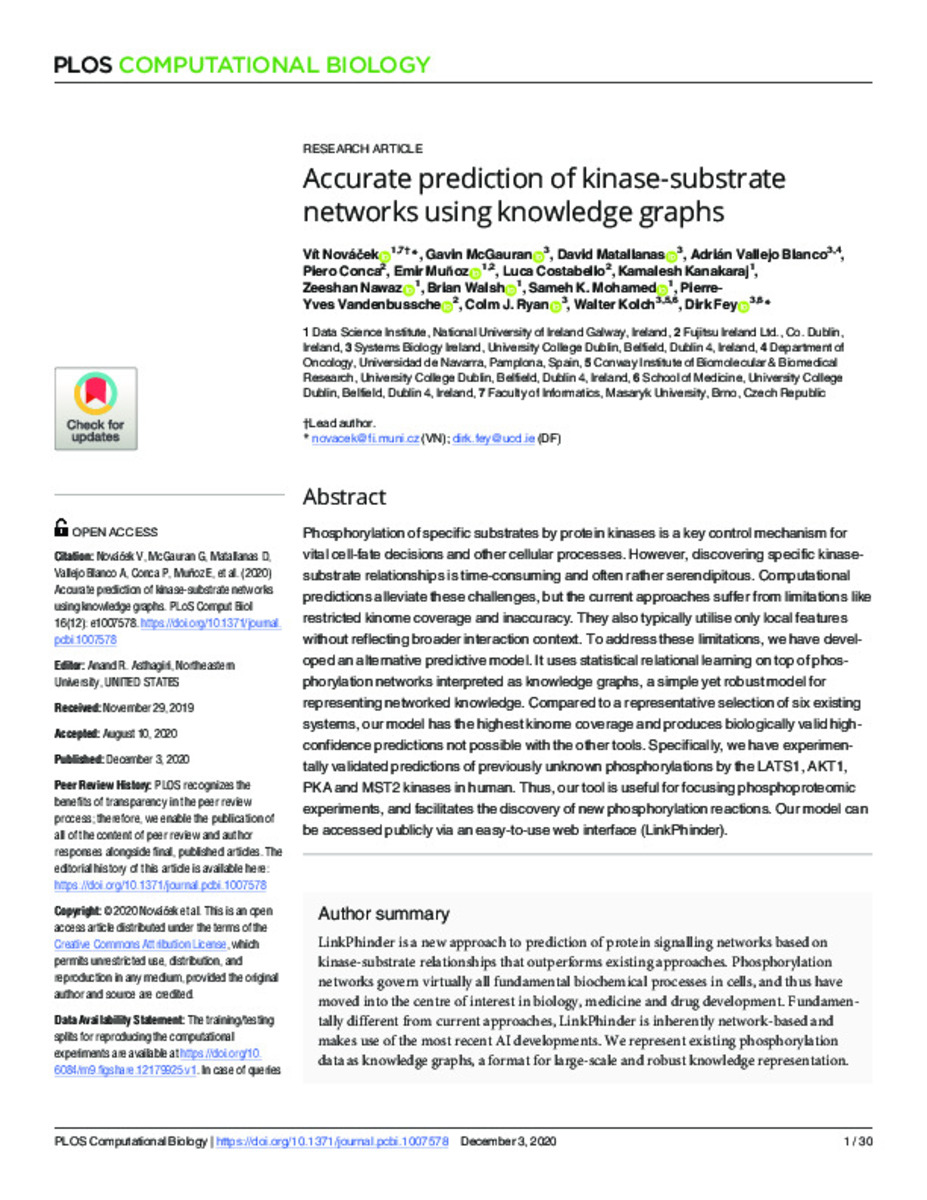Full metadata record
| DC Field | Value | Language |
|---|---|---|
| dc.creator | Novacek, V. (Vit) | - |
| dc.creator | McGauran, G. (Gavin) | - |
| dc.creator | Matallanas, D. (David) | - |
| dc.creator | Vallejo-Blanco, A. (Adrián) | - |
| dc.creator | Conca, P. (Piero) | - |
| dc.creator | Muñoz, E. (Emir) | - |
| dc.creator | Costabello, L. (Luca) | - |
| dc.creator | Kanakaraj, K. (Kamalesh) | - |
| dc.creator | Nawaz, Z. (Zeeshan) | - |
| dc.creator | Walsh, B. (Brian) | - |
| dc.creator | Mohamed, S.K. (Sameh K.) | - |
| dc.creator | Vandenbussche, P.Y. (Pierre Yves) | - |
| dc.creator | Ryan, C.J. (Colm J.) | - |
| dc.creator | Kolch, W. (Walter) | - |
| dc.creator | Fey, D. (Dirk) | - |
| dc.date.accessioned | 2023-02-06T13:45:42Z | - |
| dc.date.available | 2023-02-06T13:45:42Z | - |
| dc.date.issued | 2020 | - |
| dc.identifier.citation | Novacek, V. (Vit); McGauran, G. (Gavin); Matallanas, D. (David); et al. "Accurate prediction of kinase-substrate networks using knowledge graphs". Computational Biology. 2020, 16(12): e1007578 | es_ES |
| dc.identifier.issn | 1553-7358 | - |
| dc.identifier.uri | https://hdl.handle.net/10171/65279 | - |
| dc.description.abstract | Phosphorylation of specific substrates by protein kinases is a key control mechanism for vital cell-fate decisions and other cellular processes. However, discovering specific kinasesubstrate relationships is time-consuming and often rather serendipitous. Computational predictions alleviate these challenges, but the current approaches suffer from limitations like restricted kinome coverage and inaccuracy. They also typically utilise only local features without reflecting broader interaction context. To address these limitations, we have developed an alternative predictive model. It uses statistical relational learning on top of phosphorylation networks interpreted as knowledge graphs, a simple yet robust model for representing networked knowledge. Compared to a representative selection of six existing systems, our model has the highest kinome coverage and produces biologically valid highconfidence predictions not possible with the other tools. Specifically, we have experimentally validated predictions of previously unknown phosphorylations by the LATS1, AKT1, PKA and MST2 kinases in human. Thus, our tool is useful for focusing phosphoproteomic experiments, and facilitates the discovery of new phosphorylation reactions. Our model can be accessed publicly via an easy-to-use web interface (LinkPhinder). | es_ES |
| dc.description.sponsorship | This work was supported by the CLARIFY project funded by European Commission under the grant number 875160, the TOMOE project funded by Fujitsu Laboratories Ltd., Japan and Insight Centre for Data Analytics at National University of Ireland Galway (supported by the Science Foundation Ireland grant 12/RC/2289) and Science Foundation Ireland grants 14/IA/2395 and 15/CDA/3495 to Walter Kolch and David Matallanas, respectively. The funders had no role in study design, data collection and analysis, decision to publish or preparation of the manuscript. | es_ES |
| dc.language.iso | eng | es_ES |
| dc.publisher | PLOS | es_ES |
| dc.rights | info:eu-repo/semantics/openAccess | es_ES |
| dc.subject | Kinase-substrate networks | es_ES |
| dc.subject | LATS1 | es_ES |
| dc.subject | AKT1 | es_ES |
| dc.subject | PKA | es_ES |
| dc.subject | MST2 | es_ES |
| dc.title | Accurate prediction of kinase-substrate networks using knowledge graphs | es_ES |
| dc.type | info:eu-repo/semantics/article | es_ES |
| dc.description.note | This is an open access article distributed under the terms of the Creative Commons Attribution License | es_ES |
| dc.identifier.doi | 10.1371/journal.pcbi.1007578 | - |
| dadun.citation.number | 12 | es_ES |
| dadun.citation.publicationName | Computational Biology | es_ES |
| dadun.citation.startingPage | e1007578 | es_ES |
| dadun.citation.volume | 16 | es_ES |
| dc.identifier.pmid | 33270624 | - |
Files in This Item:
Statistics and impact
Items in Dadun are protected by copyright, with all rights reserved, unless otherwise indicated.






